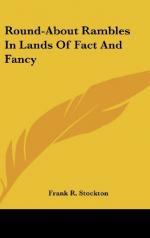Instead of a pitcher of ale on his supper-table, the good knight would have had some tea or coffee; and instead of a chine of beef, a mess of pottage, and a great loaf of brown bread for his evening meal, he would have had some white bread, cakes, preserves, and other trifles of that sort, which in the olden days were considered only fit for children and women. The good old English gentlemen were tremendous eaters. They used to take five meals a day, and each one of them was heavy and substantial.
If Sir Marmaduke had any sons or daughters, he would have treated them very differently in the present day. Instead of keeping them at home, under the tuition of some young clergyman or ancient scholar, until they should be old enough and accomplished enough to become pages to a great lord, or companions to some great lady, he would have sent them to school, and the boys—the younger ones, at least—would have been prepared for some occupation which would support them, while the girls would have been taught to play on the piano and to work slippers.
In these days, instead of that old helmet on the floor, you would have seen a high-top hat—that is, if the old gentleman should continue to be as careless as the picture shows him; instead of a cross-bow on the floor, and another leaning against the chair, you would have seen a double-barrelled gun and a powder-horn; and instead of the picturesque and becoming clothes in which you see Sir Marmaduke, he would have worn some sort of a tight-fitting and ugly suit, such as old gentlemen now-a-days generally wear.
There were a great many advantages in the old style of living, and also a very great many disadvantages. On the whole, we should be very thankful indeed that we were born in this century, and not in the good old times of yore.
A little boy once made a very wise remark on this subject. He said: “I wish I could have seen George Washington and Israel Putnam; but I’m glad I didn’t, for if I’d been alive then, I should have been dead now.”
There is enough in that boy’s remark for a whole composition, if any one chose to write it.
THE GIRAFFE.
[Illustration]
Some one once called the Giraffe a “two-story animal,” and the remark was not altogether inapplicable.
As you see him in the picture, lying down, he seems to be high enough for all ordinary purposes; but when he stands up, you will see that his legs—or his lower story—will elevate him to a surprising height.
The ordinary giraffe measures about fifteen feet from the top of his head to the ground, but some of them have been known to be over sixteen feet high. Most of this height is owing to their long necks, but their fore-legs are also very long. The hind-legs seem much shorter, although, in reality, they are as long as the fore-legs. The legs and neck of the Giraffe are made long so that he can eat the leaves from the tops of young trees. This tender foliage is his favorite diet; but he will eat the foliage from any part of a tree, and he is content with the herbage on the ground, when there is nothing else.




